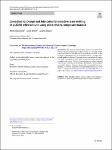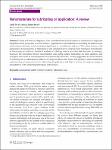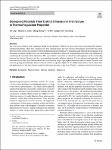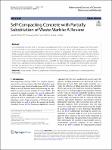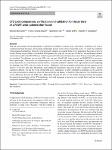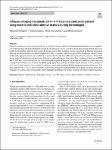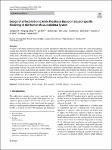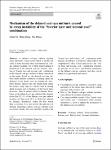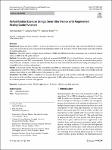Search
Author
- Osman, Ahmed I. (5)
- Daqing, Ma (3)
- Jorgensen, Ed (3)
- Li, Yan (3)
- next >
Subject
- kinh tế (26)
- Economics (12)
- programming (10)
- XRD (10)
- next >
Date issued
- 2020 - 2025 (2128)
- 2010 - 2019 (129)
- 2000 - 2009 (9)
- 1999 - 1999 (1)
Has File(s)
Search Results
This article is licensed under a Creative Commons Attribution 4.0 International License, which permits use, sharing, adaptation, distribution and reproduction in any medium or format, as long as you give appropriate credit to the original author(s) and the source, provide a link to the Creative Commons licence, and indicate if changes were made. The images or other third party material in this article are included in the article's Creative Commons licence, unless indicated otherwise in a credit line to the material. |
Friction and wear are ubiquitous, from nano-electro-mechanical systems in biomedicine to large-scale integrated electric propulsion in aircraft carriers. Applications of nanomaterials as lubricating oil additives have achieved great advances, which are of great significance to control friction and wear. This review focuses on the applications of nanomaterials in lubricating oil and comprehensively compares their tribological characteristics as lubricating oil additives. Statistical analysis of tribology data is provided and discussed accordingly; moreover, the interaction between nanomaterials and sliding surface, lubricating oil, other additives, and synergistic lubrication in nanocomposites are systematically elaborated. Finally, suggestions for future research on nanomaterials as... |
The structural evolutions of the organisms during the development of billions of years endow them with remarkable thermal-regulation properties, which have significance to their survival against the outer versatile environment. Inspired by the nature, there have been extensive researches to develop thermoregulating materials by mimicking and utilizing the advantages from the natural organisms. In this review, the latest advances in thermal regulation of bioinspired microstructures are summarized, classifying the researches from dimension. The representative materials are described with emphasis on the relationship between the structural features and the corresponding thermal-regulation functions. For one-dimensional materials, wild silkworm cocoon fibers have been involved, and the ... |
This study presents the use of sawdust ash as a substitute in the production of sustainable building materials. Inappropriate dispose of wood-waste causes serious environmental problems as it results in atmospheric degradation, emissions of greenhouse gases and the destruction of aquatic and organic products. This review article combines research results from past studies into the usage of sawdust as an alternative for essential elements in construction composites. The result of this study shows that structural concrete can be manufactured with compressive strengths more than 20 MPa by replacing moderately 5–17% of the sand with sawdust or 5–15% of the cement with sawdust ash. By partially substituting sawdust that ranges between 10 and 30% of sand used in the production of blocks a... |
Self-compacting concrete (SCC) is also seen as unsustainable since it uses a lot of natural resources. Recent researchers have focused on lowering construction costs and partially replacing cement with industrial waste. It is possible to effectively use various industrial wastes in concrete as cement or aggregates. Among these wastes, waste marble (WM) is a useful choice, and researchers have been interested in using WM in concrete for a couple of years. However, to pinpoint the advantages and recent advancements of research on WM as an ingredient of SCC, a comprehensive study is necessary. Therefore, the purpose of this study is to do a compressive evaluation of WM as an SCC ingredient. |
With the advancement of high-performance computation capabilities in recent years, high-fidelity modelling tools such as computational fluid dynamics are becoming increasingly popular in the offshore renewable sector. To justify the credibility of the numerical simulations, thorough verification and validation is essential. In this work, preparatory heave decay tests for a freely floating single cylinder are modelled. Subsequently, the surge and sway decays of a linearly moored floating offshore wind turbine model of the OC4 (Offshore Code Comparison Collaboration Continuation) phase II semi-submersible platform are simulated. Two different viscous-flow CFD codes are used: OpenFOAM (open-source), and ReFRESCO (community-based open-usage). |
The most relevant criticalities of parts produced by material extrusion additive manufacturing technologies are lower mechanical properties than standard material performances, the presence of pores caused by the manufacturing method, and issues related to the interface between layers and rods. In this context, heat treatments can be considered an effective solution for tailoring the material behavior to different application fields, especially when using precipitation hardening stainless steels. In this work, aging treatments were conducted on parts realized using three different extrusion-based processes: Atomic Diffusion Additive Manufacturing, bound metal deposition, and fused filament fabrication. |
A variety of prosthetic ankles have been successfully developed to reproduce the locomotor ability for lower limb amputees in daily lives. However, they have not been shown to sufficiently improve the natural gait mechanics commonly observed in comparison to the able-bodied, perhaps due to over-simplified designs of functional musculoskeletal structures in prostheses. In this study, a flexible bionic ankle prosthesis with joints covered by soft material inclusions is developed on the basis of the human musculoskeletal system. First, the healthy side ankle–foot bones of a below-knee amputee were reconstructed by CT imaging. |
A delayed coal–gas outburst incident often represents a more severe threat to health and safety of mine personnel than an instantaneous coal–gas outburst incident. For a better understanding of mechanism of the delayed coal–gas outburst, structure of “barrier layer and tectonic coal” combination in the delayed coal–gas outburst is firstly introduced in this paper. Based on, the delayed coal–gas outburst under different conditions of mining depth and thickness of the barrier layer are numerically simulated. Results indicate that the barrier layer enters the tertiary creep stage in a shorter time as mining depth increases and as thickness of the barrier layer decreases. Then we analyze effect of dynamic disturbance on the delayed coal–gas outburst. |
Smart-bar device (SBD) is a newly developed device to measure the body range of motion (ROM) by a kinetic sensor and to provide an exercise program with augmented reality (AR) guidance of body-frame image and audio feedback by mobile application. |

